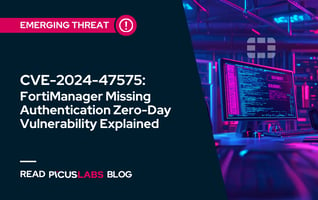2024 Breaches Unmasked (Part 6): Poor Vulnerability Management
Throughout our deep dive into 2024's most notorious breaches and their root causes, we've examined how mistakes like misconfigurations, weak credentials, lack of incident response planning and inadequate network segmentation create easy openings for cybercriminals. But even organizations that address those issues can find themselves blindsided when traditional vulnerability management practices can't keep pace with modern, dynamic IT environments.
In the past, quarterly scans and manual patching cycles might have been enough to keep threats at bay. Today, agile development and containerized deployments happen at breakneck speed, meaning attackers have more potential points of entry, while defenders often can't patch or even pinpoint vulnerabilities fast enough. It's time to rethink vulnerability management as exposure management, where the focus is on continuous identification, prioritization, and mitigation of any factor that raises an organization's attack surface.
Real-World Wake-Up Calls From 2024
- MOVEit Breach: A single critical flaw in the MOVEit Managed File Transfer tool brought 77 million records and the data of over 2,600 organizations into the CLOP malware gang's crosshairs. Even the most trusted platforms can become dangerous liabilities with just one overlooked patch. Here, the challenge wasn't just discovering the vulnerability, it was acting fast in a sprawling, interconnected environment.
- Skyrocketing Exploits: Breaches linked to vulnerability exploitation have nearly tripled compared to the previous year. Attackers aren't limiting themselves to guesswork; they're actively researching, scanning, and weaponizing well-known software weaknesses. Organizations traditionally reliant on legacy scanners and patch cycles found themselves overwhelmed. Attackers exploited newly discovered vulnerabilities faster than organizations could pivot, making many realize they needed a more holistic, context-driven strategy.
A Blueprint for Lasting Resilience: Building an Exposure Management Program
1. Establish Continuous Discovery
-
Live Asset Inventory: Track every device, container, service, and instance in real time.
-
Contextual Tagging: Organize assets by criticality to prioritize remediation.
2. Automate Security in the Pipeline
-
"Shift-Left" Practices: Integrate security checks into CI/CD workflows, identifying vulnerabilities in code before they hit production.
-
Auto-Patching & Rollback: Apply fixes quickly and revert automatically if updates break functionality.
3. Adopt Risk-Based Prioritization
-
Business Context: Weight vulnerabilities by potential impact like access to PII or core financial systems rather than just severity scores.
-
Attack Path Analysis: Understand how one exposed port or unpatched application can lead to deeper compromises, informing which patches or mitigations to tackle first.
4. Implement Continuous Security Validation
-
Breach & Attack Simulations (BAS): Go beyond vulnerability scanning by simulating real-world attacker behaviors within your environment.
-
Validate Control Effectiveness: Ensure that patches, segmentation, and access controls actually perform as intended, spotting blind spots, misconfigurations, or overlooked threats early.
-
Ongoing Optimization: Use insights from each validation exercise to fine-tune security posture, close gaps, and shorten response times.
5. Monitor & Measure Exposure Ongoing
-
KPIs & Metrics: Track mean time to detect (MTTD), mean time to remediate (MTTR), and exposure windows.
-
Threat Intelligence Feeds: Stay updated on zero-day disclosures, emerging exploit kits, and active threat actor tactics.
6. Align with Broader Security Strategy
-
Network Segmentation & Least-Privilege: Even if a zero-day exploit exists, robust internal barriers limit lateral movement.
-
Strong Incident Response: If a vulnerability is exploited, a rapid containment plan minimizes damage and speeds recovery.
Looking Ahead & Next Steps
For many organizations, vulnerability management still equals "run a scan, fix a few issues, move on." But that surface-level approach not only overlooks systemic risks, it perpetuates them. Think of every unpatched flaw as a blinking red signal to attackers. Without a culture that values security from the ground up, developers remain undertrained, leaders underestimate the danger, and vulnerabilities stack up until it's too late to avoid a breach.
Modern IT demands more than just sporadic vulnerability scans and periodic patching. Exposure management requires continuous asset tracking, risk-based prioritization, and embedded security checks, all validated through ongoing, real-world simulations. By focusing on reducing your overall attack surface, rather than chasing each vulnerability as an isolated fix, you stay ahead of adversaries who thrive on speed and automation.
While technology evolves at a breakneck pace, so do threat actors. Traditional vulnerability management simply can't keep up with today's fluid IT ecosystems. Success in 2024 and beyond hinges on making exposure management a core part of your security strategy, ensuring that at every step, you know exactly where and how your organization is vulnerable, and that you're actively validating the controls designed to keep attackers at bay.
In our next and final blog, we'll explore the Lack of Supply Chain Security. After all, a single weak link outside your walls can negate all your internal security measures, revealing why comprehensive exposure management must extend beyond your immediate perimeter and into your broader ecosystem.








